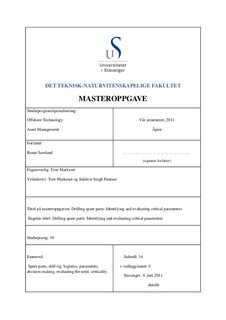| dc.description.abstract | Spare parts for drill rigs are a complicated and important task to be handled. The operations are run on tight schedules and costs are based on the number of days to complete the operations. There are strict regulations concerning the safety while running operations offshore, since consequences for both the personnel involved and the environment can be severe. To avoid having to stop the drilling operations it is very important to have a functioning system to provide spare parts if a component breaks down or need maintenance. To further complicate the handling and logistics of spare parts, a drill rig will be located at several different locations during its life time, compared to a fixed production rig, which may spend decades at one location producing hydrocarbons from an oil or gas field.
A set of parameters that affect the importance of spare parts have been set up to explain the need for spare parts, with a basis on drill rigs and their complications with being moved from one location to another. The usage rates of which parts are used, replaced or maintained play an important role and needs extensive monitoring and analysis to have a good estimate of the expected life time of a given component, part or system. Rules, regulations and criticality of equipment affect the safety of the drill rig, personnel and the environment. There need to be detailed analyses and planning of consequences, safety systems and the availability of such critical parts. Storing and transport of spare parts to offshore drill rigs will have affect on the logistics for spare parts.
Offshore drill rigs has limited storage space and weight limitations that need to be taken into consideration when deciding which spare parts are to be located on the rig, and which can be stored at onshore facilities. The concept of moving the rig after a relatively short period complicates the process of having equipment stored and establishing means of transportation. Simplified, the parts that are considered highly critical to safety, required by governmental and other regulations and parts that are essential to avoid downtime should be kept available at the rig. Such parts can be replaced with only a few hours of downtime and possibly even without stopping the operations. Less critical parts are kept at onshore storage facilities or ordered from manufacturers based on the timeframe to be available offshore. To complicate the planning of spare parts further, many parts have an unpredictable demand, some parts will become unavailable, new manufacturers and brands are introduced and delivery times may vary from the stated values. In addition to part or system history, analyses of usage rates and modeling there are recommendations from manufacturers to aid creating a system for controlling spare parts.
Finally costs will always be an important factor in decision making. The costs of having a drill rig wait for several days and the consequences of a serious accident while drilling are of such magnitude that expensive equipment, advanced monitoring, redundant systems and other safety measures may often be worthwhile. Because of the large numbers of different parts on a drill rig, the spare parts are categorized into high, medium and low criticality groups, where computerized programs and modeling has great potentials in simplifying the logistics and reducing costly over- and under stocking. Such computerized program should involves as many as possible factors and set of data available to establish a good model for the need for
iv
spare parts. The system needs to provide simple and understandable data, with possibilities for both offshore and onshore personnel to update, control and gain information on current stock, deliveries, part history and other relevant statistics. | en_US |
